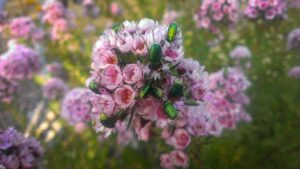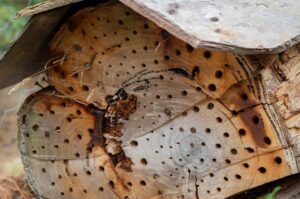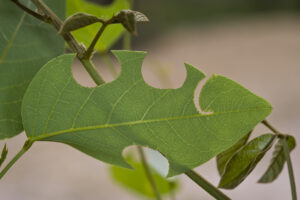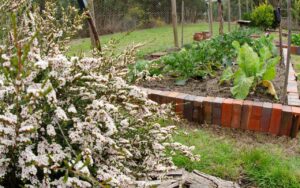
Insect pests – let ‘em rip or manage them?
By Denis Crawford
Gardening for wildlife has been in vogue for some time, but gardening for insects seems to be gaining in popularity. How do you create an insect garden without increasing pest numbers?
This Pest Files was inspired by an article I read on BBC online titled ‘Why you should let insects eat your plants’. Here is the first sentence: “Renegade gardeners across the world are embracing a new philosophy: gardening that prioritises insects, not plants.”
I must be a renegade because I have been prioritising insects in my garden for about 15 years. My aim was to attract as many insects as possible – good, bad and benign. It worked. Members of most of the common groups of insects arrived – ants, bees, wasps, mantids, flies, moths, butterflies, stick insects, lacewings, beetles, grasshoppers, katydids, bugs, and so on. The garden became a great resource for my writings and photography.

But, as they say, there is nothing new under the sun. I certainly wasn’t the first person to turn their garden into an entomologist’s paradise. A book by the behavioural ecologist John Alcock (1942-2023) titled ‘In a desert garden: Love & death among the insects’ was particularly inspirational for me.
Alcock was the Emeritus Professor in the School of Life Sciences at Arizona State University and lived in a suburb of Phoenix. In the late 1980s he converted his Bermuda grassed yard into a desert garden. Almost all the plants were Sonoran Desert species with the odd ring-in, including an Australian Eremophila species.
In his words: “from a botanical perspective, my diversified desert yard is a thousand times more interesting than the grass ‘desert’ it replaced. Moreover, it is an entomological paradise; in sum, the conversion has been richly rewarding.” I recommend Alcock’s book highly – he’s a great writer and it is beautifully illustrated by Turid Holldobler-Forsyth.
It is interesting to note that Arizona residents these days have widely embraced xeriscaping (the practice of drought-proofing a landscape) to adapt to the desert climate. As well as adopting water-efficient irrigation systems, gardeners are also growing plants that are more suited to the climate. Those gardeners that still crave a green swathe of lawn have resorted to artificial turf.
In my garden I didn’t need to recreate the bush, because living on a bush-block I was surrounded by it. My thing is growing fruit and vegetables, so I fenced off an area 8m x 30m with a 2.5m high fence to keep out the wallabies, kangaroos and feral deer. Once I had planted the fruit trees, created the vegetable beds and established a herb garden, I added in some native shrubs such as thyrptomene, leptospermum, hardenbergia, Sweet Bursaria and Chamelaucium x Verticordia ‘Paddy’s Pink’. Other beds had plants like African daisy, salvia, sedum and even a rose bush.

One of my aims was to attract as many native insects as possible into my garden, hence the native and exotic ornamental plants. In particular, I was interested in seeing if I could get some native bees to nest in the garden. To that end, I created some ‘bee hotels’. Some were 3m poles set vertically in the ground with holes drilled for the bees to nest in. Others were round slabs of wood about 200 mm thick with holes drilled in the face of the slab. The poles and the slabs were cut from Messmates (Eucalyptus obliqua).
The ‘bee hotels’ were a spectacular success. Many of the holes in the slabs were occupied by resin bees (Megachile spp.) and grass-carrying wasps, and many holes in the vertical poles were occupied by grass-carrying wasps (Isodontia sp.). The benefits of having native bees in the garden are pretty obvious, but the benefits of grass-carrying wasps may need an explanation. These wasps are predators of katydids, crickets and grasshoppers which they catch, paralyse and place in the holes. The wasps then lay an egg near the prey so the hatching larvae will have food. The wasps then seal the hole with grass, often leaving grass stems protruding.
About half of our native bee species nest in the ground, so I made sure there were areas of bare soil for them and other ground-nesting insects, such as sand wasps, to nest in. I saw native bees flying in and out of holes in the ground from time to time, but the leaf-cutting bees (Megachile sp.) found a different place to nest. My vegetable beds were slightly raised using extruded bricks left over from the house build. Rather than cement them in, I placed the bricks on their ends and wired them together in groups of ten. The leaf-cutting bees used the soil in the space between the groups of bricks. You may be wondering which plant’s leaves the leaf-cutting bees used? Hardengbergia – leaf-cutting bees love those leaves, and that’s why it was in the garden.
Getting those vegetable beds established required a lot of work. The soil is very sandy on my property, so a lot of organic material was required. My compost bins generated about 1m³ of compost every year, but that wasn’t enough. I had to supplement the compost with bags of cow manure and mushroom compost as well as all the previous year’s straw mulch. It still didn’t seem enough sometimes. The joys of gardening in sandy soil!
The vegetables were a target for pest insects of course. Some of those pests, particularly aphids, were controlled by beneficial insects such as ladybird beetles, hover flies, lacewings and parasitic wasps that were all present in the garden.

My favourite story about aphids involves one of the thryptomene bushes that I planted in the garden. In early spring some cabbage aphids were becoming established on my broccoli plants, but they were soon found by parasitic wasps. These wasps require a feed of nectar, and luckily the thryptomene bush, a couple of metres away was flowering profusely. Thryptomene flowers are small open flowers, ideally suited to tiny parasitic wasps. I sat there and watched the little wasps hunting on the plant for aphids, laying an egg in each one, and then flying to the thryptomene to fuel up on nectar.
The rose bush mentioned earlier was planted just so I could see what would happen when the rose aphids (Macrosiphum rosae) arrived. I didn’t have to wait long – hover fly larvae annihilated the aphid colonies in a matter of days. I never had to spray any aphids in the garden.
It’s not so easy with one of the fruit tree pests, the pear and cherry slug (Caliroa cerasi), a prolific leaf skeletoniser. There are no known parasites of pear and cherry slug in Australia. This pest needs a hands-on approach. The ‘slug’ is actually the larva of a sawfly, and it is prone to desiccation. To control pear and cherry slug I dusted the pear and cherry trees with wood ash.
Another pest that required intervention was the cabbage white butterfly (Pieris rapae). The butterflies arrived in the garden in such high numbers and laid so many eggs that all the beneficial insects present (ladybirds, lacewings, damsel bugs and several species of parasitic wasps) usually couldn’t prevent damage to my brassica plants. Intervention was very simple – I installed nets over the crops to prevent the butterflies laying their eggs.
Other ‘pests’ were quite desirable, for example the larvae of swallowtail butterflies (Papilio spp.) which chewed the leaves of the citrus trees. A few chewed leaves were a small price to pay for the pleasure of watching beautiful swallowtails in the garden.
Insects are vital to most of the Earth’s terrestrial ecosystems. Despite the positive benefits of having a diversity of insects in the garden (e.g. pollination, pest control, decomposition etc.) there are some insects that may cause problems. Those pests should be controlled but you don’t necessarily have to resort to insecticides.
You may have noticed that I have written about my garden in the past tense. The bushfire of February 13th of this year turned my beloved insect garden to cinders. I will not be restoring it.
